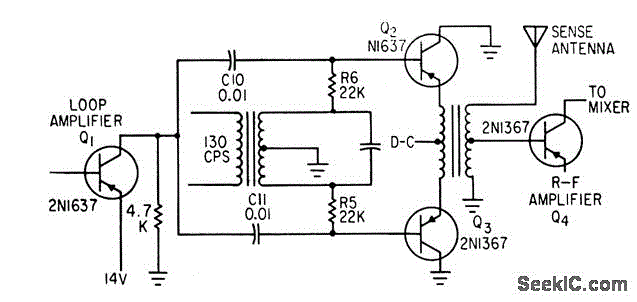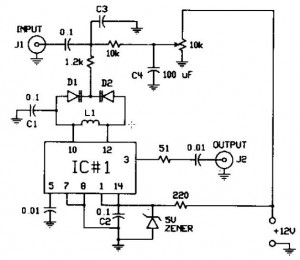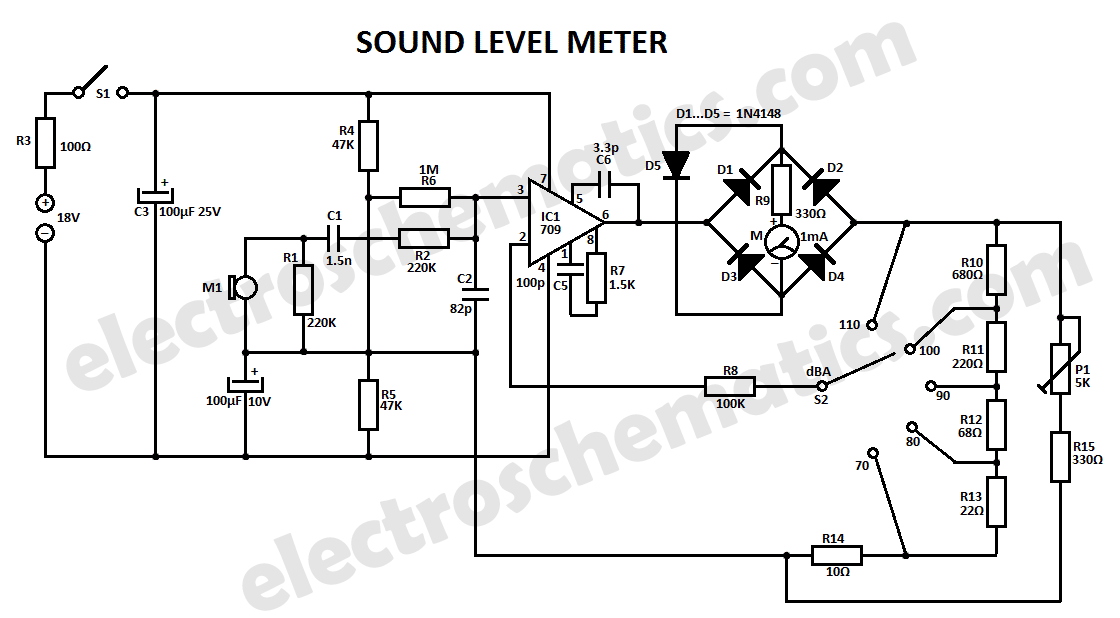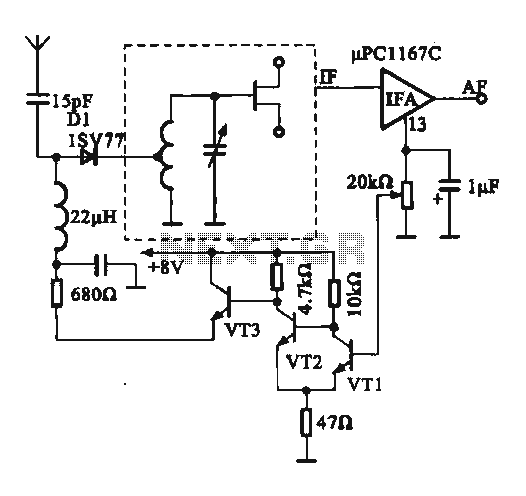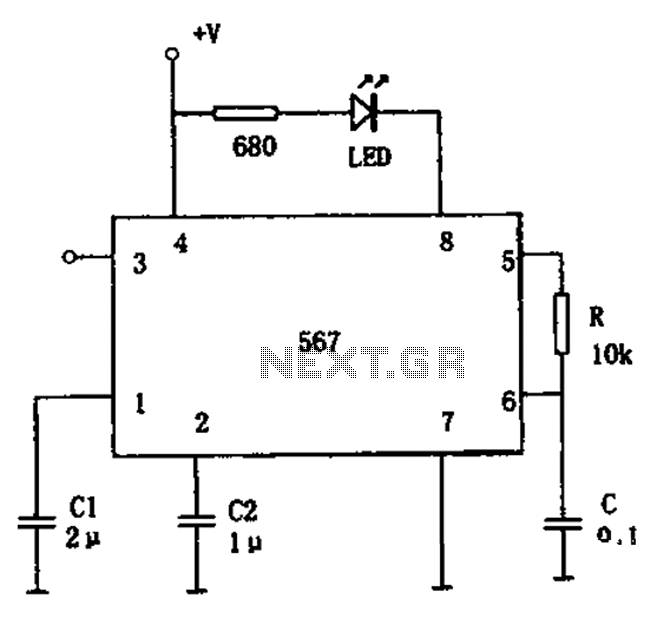
SSB Modulator
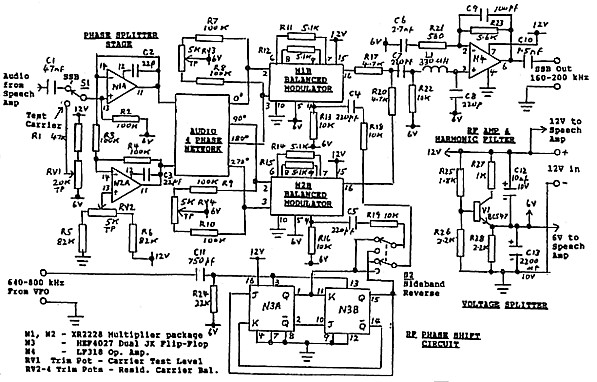
The circuit details are presented in Figure 3. The primary components of the system include a speech amplifier, an audio phase shift network with a balanced driver circuit (N1A, N2A), two balanced modulator stages (N1B & N2B), an RF carrier phase shift circuit (N3), and an output RF driver stage that incorporates a low-pass filter (N4). Various well-known integrated circuit packages, such as the MC1496, NE602, and SL1640, could have been utilized as balanced modulators. However, XR2228 Monolithic Multiplier packages were chosen for this design, with two of them (N1 & N2) serving these functions. These devices feature balanced X and Y input circuits, a balanced output, and a configuration suitable for a balanced modulator. They are capable of handling frequencies up to approximately 3 MHz, which is well within the required LF range. Each XR2228 package includes an operational amplifier (N1A & N1B), which is used to create a balanced low impedance driver for the audio phase network. The outputs of the amplifiers are directly coupled through the network to the X inputs of the balanced modulator sections (N1B & N2B). Precise DC balance for optimal carrier rejection is achieved through trimpot RV2. It is noted that using a separate op-amp package for the driver might have been a better choice, as this configuration resulted in a high concentration of components around the XR2228 units. To improve residual carrier balance, trimpots RV3 and RV4 were later added, allowing for individual adjustments of the two balanced modulators to enhance the rejection of residual carrier. A 90-degree phase shift for one of the RF carriers can be accomplished using simple reactive circuits; however, this method is limited to a single frequency. Instead, a circuit utilizing two type D or JK flip-flops can generate two outputs that are 90 degrees apart for any frequency that the flip-flops can accommodate. For this purpose, a LOCMOS dual JK flip-flop type HEF4027 (N3) is employed. The circuit requires a drive frequency that is four times the carrier frequency; thus, for a transmitter operating at 160 to 200 kHz, a drive frequency of 640 to 800 kHz is needed from the VFO. Switching between upper and lower sidebands is accomplished by reversing the output leads from N3 that connect to the two balanced modulators, with switch S2 provided for this function. The outputs from the two balanced modulators are combined at the junction of resistors R17 and R20. The single sideband output alone is insufficient to drive the transmitter input, and amplifier N4 increases the output level by a factor of 10. The modulator output contains higher order frequency components, and components L1-C8 and R23-C9 create a frequency roll-off above 200 kHz to attenuate these components. This constitutes the only frequency-dependent section of the SSB system, limiting operations above 200 kHz. Higher order frequency components are further mitigated by the low-pass filter at the transmitter output. Limited tests indicated that the system could generate single sideband signals at frequencies up to 3.5 MHz, likely constrained by the characteristics of the XR2228 packages. It is suspected that higher frequencies could be achieved using packages like the NE602. Additionally, higher frequencies may be attainable through heterodyning. The circuit can switch from SSB to a constant carrier for testing or CW mode by operating switch S1, which unbalances the modulators to allow the carrier to pass through. The carrier level is controlled by the degree of unbalance set by trimpot RV1, and the switch also disconnects the speech amplifier to prevent modulation.
The described circuit represents a sophisticated design for generating single sideband (SSB) signals, integrating various components that contribute to its functionality. The speech amplifier serves as the initial stage, amplifying audio signals before they are processed by the audio phase shift network. The balanced driver circuit ensures that the modulated signals maintain a balanced output, which is critical for reducing distortion and improving signal integrity.
The choice of XR2228 packages as balanced modulators is significant due to their inherent design, which accommodates balanced inputs and outputs, facilitating effective modulation. The operational amplifiers integrated within the XR2228 packages enhance the circuit's performance by providing necessary amplification while maintaining low impedance driving capabilities.
The implementation of trimpots for DC balance adjustments underscores the importance of precision in RF applications. By allowing fine-tuning of the modulator balance, the circuit can achieve optimal carrier rejection, which is vital for maintaining signal clarity and minimizing unwanted artifacts.
The use of flip-flops for generating phase-shifted signals introduces flexibility into the design, enabling the system to adapt to various frequency requirements. This design choice enhances the circuit's versatility, allowing it to operate across a range of frequencies while maintaining the desired phase relationships.
The final output stage, incorporating a low-pass filter, addresses the need to suppress higher order harmonics that may interfere with the intended signal. This filtering is crucial for ensuring compliance with regulatory standards and improving overall signal quality.
Overall, the circuit is a well-thought-out design that balances complexity with functionality, providing a robust solution for generating single sideband signals in the specified frequency range.Circuit detail is shown in figure 3. The main elements of the system are a speech amplifier, the audio phase shift network with balanced driver circuit (N1A, N2A), two balanced modulator stages (N1B & N2B), an RF carrier phase shift circuit (N3) and an output RF driver stage incorporating a lowpass filter (N4). A number of different well known inte grated circuit packages such as the MC1496, NE602 and the SL1640 could have been used as balanced modulators. However I happened to have a number of XR2228 Monolithic Multiplier packages and two of these (N1 & N2) are used for these functions.
These devices have balanced X and Y input circuits, a balanced output and a circuit arrangement which looked ideal for a balanced modulator. They can also handle frequencies up to around 3 MHz, well above our LF range. The XR2228 packages also include an operational amplifier each (N1A & N1B) and the pair of these are used to form a balanced low impedance driver for the audio phase network.
The amplifier outputs are directly coupled through the network to the X inputs of the balanced modulator sections of the packages (N1B & N2B). Precise DC balance of the complete circuit (necessary to set to for best carrier rejection) is set by trimpot RV2.
In retrospect, my thoughts are that it might have been better to use a separate op amp package for the driver as the arrangement resulted in the concentration of a lot of components around the two XR2228 units. Concerning residual carrier balance, a later addition was the inclusion of trimpots RV3 and RV4 which allow individual adjustment balance of the two balanced modulators and further improvement in the rejection of residual carrier.
A 90 degree phase shift for one of the RF carriers can easily be achieved with simple reactive circuits but this system is somewhat confined to a single frequency. Instead, a circuit using two type D or JK flip-flops can provide two outputs 90 degrees apart for any frequency the flip-flops can handle.
For this function, LOCMOS dual JK flip-flop type HEF4027 (N3) has been used. One characteristic of the circuit is that it requires a drive frequency four times the carrier frequency so that for the 160 to 200 kHz transmitter, we need 640 to 800 kHz drive from the VFO. Change between upper and lower sideband is simply achieved by reversing the output leads from N3 which feed the two balanced modulators.
Switch S2 is provided for this purpose. The outputs from the two balanced modulators are combined at the junction of R17 and R20. The single sideband output is insufficient to drive the input of the transmitter and amplifier N4 raises the output level by a factor of 10. The output from the modulators contains higher order frequency components and L1-C8 and R23 -C9 provide a frequency roll-off above 200 kHz to attenuate these components.
This is are the only frequency dependent section of the SSB system, limiting operation much above 200 kHz. Higher order frequency components are further attenuated in the low-pass filter at the output of the transmitter.
As a matter of interest I did carry out some limited tests to see how high a frequency the system could be made to work. (Of course not including the output filters just discussed). I found I could generate single sideband at frequencies as high as 3. 5 MHz, limited probably by the characteristics of the XR2228 packages. I suspect the modulators could be made to go higher using packages such as the NE602. Further to that, higher frequencies could be achieved by heterodyning. The circuit can be switched from SSB to constant carrier for testing or for CW mode by operating switch S1.
It achieves this by unbalancing the modulators to allow carrier to get through. The level of carrier is determined by the degree of unbalance set by trim-pot RV1. The switch also disconnects the speech amplifier so that modulation cannot take place. Whilst I haven`t allowed for it in the 🔗 External reference
The described circuit represents a sophisticated design for generating single sideband (SSB) signals, integrating various components that contribute to its functionality. The speech amplifier serves as the initial stage, amplifying audio signals before they are processed by the audio phase shift network. The balanced driver circuit ensures that the modulated signals maintain a balanced output, which is critical for reducing distortion and improving signal integrity.
The choice of XR2228 packages as balanced modulators is significant due to their inherent design, which accommodates balanced inputs and outputs, facilitating effective modulation. The operational amplifiers integrated within the XR2228 packages enhance the circuit's performance by providing necessary amplification while maintaining low impedance driving capabilities.
The implementation of trimpots for DC balance adjustments underscores the importance of precision in RF applications. By allowing fine-tuning of the modulator balance, the circuit can achieve optimal carrier rejection, which is vital for maintaining signal clarity and minimizing unwanted artifacts.
The use of flip-flops for generating phase-shifted signals introduces flexibility into the design, enabling the system to adapt to various frequency requirements. This design choice enhances the circuit's versatility, allowing it to operate across a range of frequencies while maintaining the desired phase relationships.
The final output stage, incorporating a low-pass filter, addresses the need to suppress higher order harmonics that may interfere with the intended signal. This filtering is crucial for ensuring compliance with regulatory standards and improving overall signal quality.
Overall, the circuit is a well-thought-out design that balances complexity with functionality, providing a robust solution for generating single sideband signals in the specified frequency range.Circuit detail is shown in figure 3. The main elements of the system are a speech amplifier, the audio phase shift network with balanced driver circuit (N1A, N2A), two balanced modulator stages (N1B & N2B), an RF carrier phase shift circuit (N3) and an output RF driver stage incorporating a lowpass filter (N4). A number of different well known inte grated circuit packages such as the MC1496, NE602 and the SL1640 could have been used as balanced modulators. However I happened to have a number of XR2228 Monolithic Multiplier packages and two of these (N1 & N2) are used for these functions.
These devices have balanced X and Y input circuits, a balanced output and a circuit arrangement which looked ideal for a balanced modulator. They can also handle frequencies up to around 3 MHz, well above our LF range. The XR2228 packages also include an operational amplifier each (N1A & N1B) and the pair of these are used to form a balanced low impedance driver for the audio phase network.
The amplifier outputs are directly coupled through the network to the X inputs of the balanced modulator sections of the packages (N1B & N2B). Precise DC balance of the complete circuit (necessary to set to for best carrier rejection) is set by trimpot RV2.
In retrospect, my thoughts are that it might have been better to use a separate op amp package for the driver as the arrangement resulted in the concentration of a lot of components around the two XR2228 units. Concerning residual carrier balance, a later addition was the inclusion of trimpots RV3 and RV4 which allow individual adjustment balance of the two balanced modulators and further improvement in the rejection of residual carrier.
A 90 degree phase shift for one of the RF carriers can easily be achieved with simple reactive circuits but this system is somewhat confined to a single frequency. Instead, a circuit using two type D or JK flip-flops can provide two outputs 90 degrees apart for any frequency the flip-flops can handle.
For this function, LOCMOS dual JK flip-flop type HEF4027 (N3) has been used. One characteristic of the circuit is that it requires a drive frequency four times the carrier frequency so that for the 160 to 200 kHz transmitter, we need 640 to 800 kHz drive from the VFO. Change between upper and lower sideband is simply achieved by reversing the output leads from N3 which feed the two balanced modulators.
Switch S2 is provided for this purpose. The outputs from the two balanced modulators are combined at the junction of R17 and R20. The single sideband output is insufficient to drive the input of the transmitter and amplifier N4 raises the output level by a factor of 10. The output from the modulators contains higher order frequency components and L1-C8 and R23 -C9 provide a frequency roll-off above 200 kHz to attenuate these components.
This is are the only frequency dependent section of the SSB system, limiting operation much above 200 kHz. Higher order frequency components are further attenuated in the low-pass filter at the output of the transmitter.
As a matter of interest I did carry out some limited tests to see how high a frequency the system could be made to work. (Of course not including the output filters just discussed). I found I could generate single sideband at frequencies as high as 3. 5 MHz, limited probably by the characteristics of the XR2228 packages. I suspect the modulators could be made to go higher using packages such as the NE602. Further to that, higher frequencies could be achieved by heterodyning. The circuit can be switched from SSB to constant carrier for testing or for CW mode by operating switch S1.
It achieves this by unbalancing the modulators to allow carrier to get through. The level of carrier is determined by the degree of unbalance set by trim-pot RV1. The switch also disconnects the speech amplifier so that modulation cannot take place. Whilst I haven`t allowed for it in the 🔗 External reference

